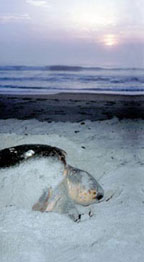 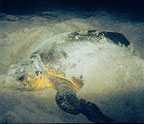 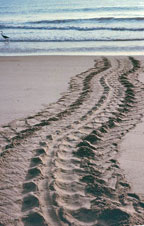 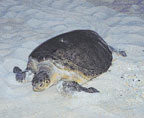 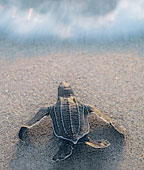 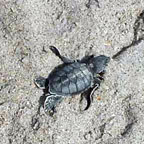  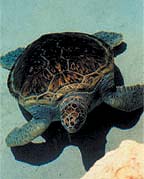 |
 Canaveral
National Seashore serves as an important nesting area for sea turtles.
During the months of May through August, giant sea turtles lumber ashore
to nest on the beach. Three species are know to nest within the park;
the loggerhead, leatherback and green sea turtle. Loggerheads lay 3,000
- 4,000 nests per year. Up to three hundred greens and only a few
leatherbacks deposit their eggs within the park boundaries each nesting
season.
Canaveral
National Seashore serves as an important nesting area for sea turtles.
During the months of May through August, giant sea turtles lumber ashore
to nest on the beach. Three species are know to nest within the park;
the loggerhead, leatherback and green sea turtle. Loggerheads lay 3,000
- 4,000 nests per year. Up to three hundred greens and only a few
leatherbacks deposit their eggs within the park boundaries each nesting
season. The sea turtles lay approximately 100 round, white, leathery eggs in each nest. Prior to 1984, most of the eggs laid within the seashore were eaten by raccoons, and to a lesser extent by ghost crabs. Some nests are lost when beaches erode during storms.
In the early 1980's researchers found raccoons were destroying 98 percent of Canaveral's turtle nests. The park began a program to help reverse this trend. After experimenting with several different ways of protecting the eggs, park rangers found that by securing a wire mesh screen over the nest, raccoons were prevented from digging in to the nests. The small hatchlings could still exit the next through the openings in the mesh. During the months of May through August, park rangers and volunteers work each night to screen the nests. After two months, when all the eggs have hatched, the screens are removed. Over 80 percent of the turtle nests have been protected using this method. Since the 1980's Canaveral National Seashores conservation efforts has a 90% success rate.
An important part of the seashore conservation efforts has been the education of the public. Every June and July guests come to the Sea Turtle Watch Program, not only do guests get to watch a loggerhead sea turtle lay her eggs, they also get to learn about the importance of the sea turtles to our environment, and learn how they can help this species survive. Turtle watch program information will be found here in season.
| Click photo for page with details. | ||||||
 Loggerhead |  Green |  Leatherback |  Kemps Ridley |
|||
|
TURTLE WATCH RESERVATIONSThe 2024 programs are open to all persons eight (8) years of age and older. Reservations have a maximum of six (6) persons per reservation. The fee for this program is $20.00 per person ages 16 and above. The programs will be presented in both Districts and run from 8:00 PM until midnight on June 1, 7, 8, 14, 15, 21, 22, 28, and 29. Turtle Watch programs give park visitors a unique opportunity to see a live sea turtle nesting. Link coming 5/15/24. |
 Unlike other turtles, sea
turtles cannot retract their legs and head into their shells.
Unlike other turtles, sea
turtles cannot retract their legs and head into their shells. Turtles do not have teeth, but the
jaws are shaped to provide crushing, biting or tearing surfaces
appropriate for their diet.
Turtles do not have teeth, but the
jaws are shaped to provide crushing, biting or tearing surfaces
appropriate for their diet. Like all reptiles, sea turtles lack external ears and the eardrum is
covered with skin.
Like all reptiles, sea turtles lack external ears and the eardrum is
covered with skin. Growth rates
vary, but most sea turtle species mature slowly and all have a long life
span.
Growth rates
vary, but most sea turtle species mature slowly and all have a long life
span. Temperatures of the sand
where the turtles nest determine the sex of the turtle: below 85 degrees
Fahrenheit is predominately male; above 85 degrees Fahrenheit is
predominately female.
Temperatures of the sand
where the turtles nest determine the sex of the turtle: below 85 degrees
Fahrenheit is predominately male; above 85 degrees Fahrenheit is
predominately female. Sea
turtles also have a special adaptation process wherein they extract
water from the food they intake and by metabolizing saltwater; as such
they can survive in the ocean without the requirement of freshwater or
a freshwater source.
Sea
turtles also have a special adaptation process wherein they extract
water from the food they intake and by metabolizing saltwater; as such
they can survive in the ocean without the requirement of freshwater or
a freshwater source. In
addition to solving the problems of swimming and breathing, sea turtles
have also come up with an ingenious way to rid their bodies of the salts
they accumulate from the saltwater in which they live. Just behind each
eye is a salt gland. The salt glands help sea turtles to maintain a
healthy water balance by shedding large "tears" of excess salt. If a sea
turtle appears to be "crying" it is usually not cause for alarm, as the
turtles are merely keeping their physiology in check.
In
addition to solving the problems of swimming and breathing, sea turtles
have also come up with an ingenious way to rid their bodies of the salts
they accumulate from the saltwater in which they live. Just behind each
eye is a salt gland. The salt glands help sea turtles to maintain a
healthy water balance by shedding large "tears" of excess salt. If a sea
turtle appears to be "crying" it is usually not cause for alarm, as the
turtles are merely keeping their physiology in check.
 Take all the items you brought to the beach with you when you go.
Take all the items you brought to the beach with you when you go. Do not leave litter on the beach
which may disorient nesting females as they crawl out of the ocean.
Do not leave litter on the beach
which may disorient nesting females as they crawl out of the ocean. Fill in any holes you may have dug
on the beach which may trap nesting turtles and hatchlings.
Fill in any holes you may have dug
on the beach which may trap nesting turtles and hatchlings. If you see a turtle on the beach -
do not touch or disturb the turtle.
If you see a turtle on the beach -
do not touch or disturb the turtle. Turn off all lights at night on the beach -
it's the law.
Turn off all lights at night on the beach -
it's the law. Do not take flash
photos of turtles.
Do not take flash
photos of turtles. Never throw
trash into the water.
Never throw
trash into the water. Volunteer
for beach cleanups.
Volunteer
for beach cleanups. Participate
in organized turtle watches.
Participate
in organized turtle watches. Never buy products made from endangered species.
Never buy products made from endangered species. Say NO! to plastic. Use recyclable shopping
bags and drinking bottles. The ocean is littered with 47,000 pieces of
plastic per square mile.
Say NO! to plastic. Use recyclable shopping
bags and drinking bottles. The ocean is littered with 47,000 pieces of
plastic per square mile. Pick
up discarded fishing line - it takes 600 years to bio-degrade.
Pick
up discarded fishing line - it takes 600 years to bio-degrade. Buy a Sea Turtle Specialty License
Plate for your vehicle. Revenue from the sale of sea turtle license
plates goes to support sea turtle research, conservation and education
in Florida.
Buy a Sea Turtle Specialty License
Plate for your vehicle. Revenue from the sale of sea turtle license
plates goes to support sea turtle research, conservation and education
in Florida. If you find an
injured or dead turtle in Florida, call the Fish and Wildlife
Conservation Commission Law Enforcement at (1-888-404-FWCC).
If you find an
injured or dead turtle in Florida, call the Fish and Wildlife
Conservation Commission Law Enforcement at (1-888-404-FWCC).
About the National Park Service. More than 20,000 National Park Service employees care for America's 401 national parks and work with communities across the nation to help preserve local history and create close-to-home recreational opportunities. Learn more at www.nps.gov.